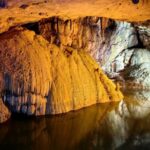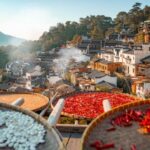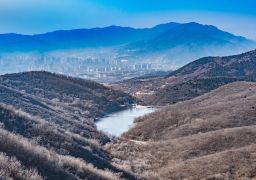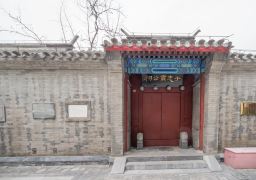Jianglang Mountain, commonly known as Sanpian Stone, is composed of the stone peaks Lang Peak, the stone column Ya Peak, and the stone wall Ling Peak. These three massive stones resemble three stone shoots growing from the ground, forming a shape reminiscent of the Chinese character for ‘river’, and are characteristic of the typical Danxia landform. Climbing here feels thrilling, with the deep One-Line Sky and long nearly vertical steep steps, the difficulty of which is comparable to Huashan.
On the highway near the scenic area entrance, one can conveniently view the panoramic view of Jianglang Mountain, with different scenes emerging as the location changes. The ticket includes the cost of the sightseeing bus, allowing visitors to take a ride from the visitor center to the area near Kaiming Zen Temple at the foot of the mountain before starting the climb. On ordinary days, private cars can also drive to the parking lot at the foot of the mountain. Along this road, one can enjoy a distant view of the Jianglang Mountain panorama, with a symbolic large banyan tree that people enjoy using as a foreground for photography.
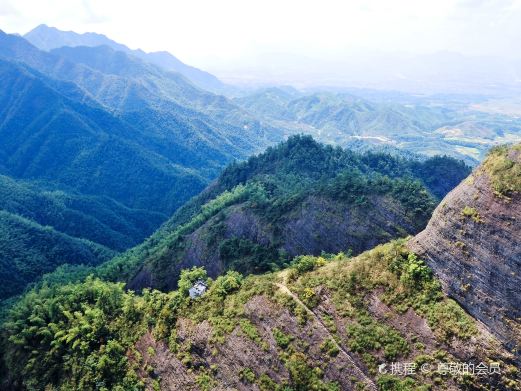
There are two paths to climb the mountain: one is the South Line leading to One-Line Sky, and the other is the North Line heading to the Yanxia Pavilion. Most people choose to ascend via the Shibazhu – Kaiming Zen Temple – Huixian Rock – One-Line Sky – Dengtian Ping – Wenti Pavilion (South Line), and then descend via the North Line. This is because the South Line has a more gentle slope, while the North Line features large sections of nearly vertical iron ladders, with narrow paths offering no place to rest. Descending is manageable, but ascending might be overwhelming. It typically takes an average person four to five hours to complete the round trip.
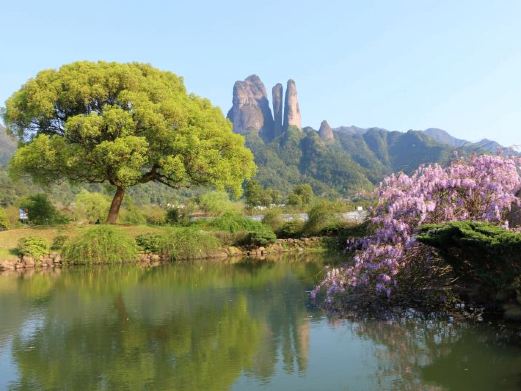
Huixian Rock is the starting point for climbing, where one chooses the path leading to One-Line Sky. Walking and sightseeing to One-Line Sky takes about an hour, with a relatively gentle path. Although Jianglang Mountain’s One-Line Sky is not particularly narrow, it is profound and is a must-visit and must-photograph spot for all visitors. In cloudy and misty weather, the mist that envelops between the two mountain walls gives one a feeling of being in a different realm. Generally, tour groups return after visiting One-Line Sky, but those intending to climb must continue towards Dengtian Ping.
Standing on the mountain and looking at the winding and steep steps is quite thrilling. On the way down the mountain, there is a section of canyon without light, but this section is not long. At the boarding point at the foot of the mountain, if there is enough time, you can walk in the direction of Xunv Lake from here. It takes about 40 minutes to reach. Xunv Lake is a reservoir with some artificial leisure landscapes.
Here, you can view the panorama of Jianglang Mountain from a distance. If you don’t want to climb the mountain, you can come here for a distant view. However, not many tourists come here. There are farmhouses near the scenic area where you can stay. Tourists who come here often choose to spend two or three days visiting together with Nianbadu and Fugai Mountain in the surrounding area. Opening hours: Open all year round from 08:00 to 17:00. Preferential policies: Children: Those with a height between 1.2m (inclusive) and 1.5m (inclusive) (50% off the listed price), half price. The elderly: Those aged 70 years old (inclusive) and above with valid certificates are free; those aged 60 years old (inclusive) to 69 years old (inclusive) with valid certificates (50% off the listed price), half price. Students: Primary and middle school students with valid certificates (50% off the listed price), half price. Disabled people: With valid disability certificates, free. Military personnel: Active servicemen, revolutionary disabled soldiers, and families of martyrs with valid certificates, free. Journalists: With valid certificates, free. Model workers, blood donors, and tour guides: Model workers at or above the Quzhou municipal level with valid certificates, with Zhejiang Province’s honorary certificate for unpaid blood donation, and tour guides with valid certificates, free. Service facilities: Parking lot: [Jianglang Mountain Scenic Area uphill parking lot]. Reference price: Free within 15 minutes. Specific charges are subject to on-site prices. Address: At the entrance on the mountainside of Jianglang Township, Jiangshan City, Quzhou City. Number of parking spaces: 20. Nursing room: Address: Tourist center.

